-
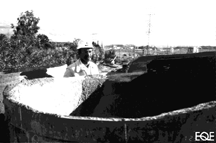
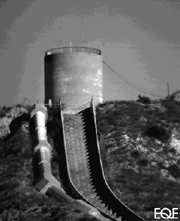
Left: Tensile failure of a 210-cm, welded steel, intake water supply pipe at the Joseph Jensen Filtration Plant.
Right: The Los Angeles aqueduct was dewatered in order to repair breaks in the system.
Water and Wastewater
Water service to the San Fernando Valley is provided by the Metropolitan Water District (MWD) and the Los Angeles Department of Water and Power (DWP) via two water treatment plants. MWD’s Joseph Jensen Filtration Plant and DWP’s Los Angeles Aqueduct Filtration Plant are near the junction of Interstates 5 and 210 (about 11 km northeast of the epicenter). As in the 1971 San Fernando Earthquake, this area was subjected to very strong ground motions and had extensive soil liquefaction. The soil liquefaction and settlement in this earthquake led to moderate damage to the Los Angeles aqueduct, treatment plant structures and basins, and underground piping. Although both treatment plants were knocked out of service temporarily, storage reservoirs and other treatment plants outside the immediate area that remained on-line supplied water to most of the valley. A boil order remained in effect for two weeks because of possible contamination from the numerous breaks in supply lines throughout the distribution system. Service restoration was rapid, considering the many buried piping failures caused by ground disturbances and the strong ground motions that occurred. This good performance was primarily attributable to built-in system redundancies and good response from repair crews.
At the 400 million gallon per day (mgd) Jensen filtration plant, liquefaction-related soil settlement and lateral spreading, evident around the main control building and adjacent parking area, were again the primary cause of damage and plant shutdown. Settlements of up to 15 cm and lateral movements of more than 8 cm occurred. This soil failure damaged buried incoming electrical conduits; a 210-cm, welded steel, intake water supply line; and a 15-cm, PVC chlorine solution line. Other treatment structures and equipment had minor damage, except for the control building, which had extensive interior damage and moderate structural damage. Because of power loss to the plant and damage to the intake line, the treatment plant was taken off-line for 36 hours while repairs were made. Flow, however, continued out of the 50-million-gallon clearwell for 48 hours. This plant was back in full operation within a week after the earthquake.
-
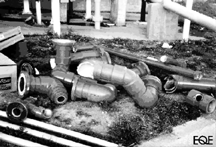
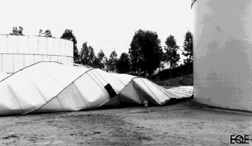
Top: Fractured PVC chlorine solution pipes at the Los Angeles Aqueduct Filtration Plant. These pipes were not laterally braced to the overflow structure.
Left: Collapse of a 750,000-gallon water storage tank near Castaic Junction.
Possible liquefaction and soil settlement of 15 to 20 cm caused extensive damage to supply lines and treatment structures, basins, and piping at the 600-mgd Los Angeles Aqueduct Filtration Plant, constructed in 1986. Widespread cracking (up to 2.5 cm) was observed in the concrete intake Los Angeles aqueduct canal and inlet structure. Similar cracking was observed in the pre-filter channel and filters, particularly at construction joints. All of these cracks and joint movements led to extensive leakage into underground pipe and utility galleries. To restore operations and stop leaks as soon as possible, the plant was dewatered, and cracks and spalls were temporarily sealed. The sealant failed at a few locations, requiring the northern half of the plant to be taken out of service two weeks after the earthquake. At the overflow structure, several PVC chlorine solution lines fractured because of inadequate bracing. Power was lost to this plant for about 6 hours. Half of the plant, however, could not return to operation for another six days because of conduit and piping damage induced by soil settlement at the power and chlorine feeds.
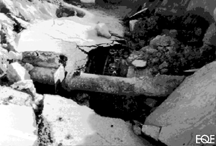
Broken water and gas mains on Balboa Boulevard in an area of extensive ground failures possibly caused by faulting. The broken gas main (foreground) ignited and caused a fire that burned down five houses and damaged several more.
DWP’s distribution system includes more than 100 storage reservoirs; 11,200 km of mains; and 630,000 service connections. Storage reservoirs generally performed well, except for a few aboveground steel tanks. Nine of these (0.5- to 2.5-million-gallon) tanks failed in the earthquake. Tank failures were caused by failure at bases (tearing and buckling) and roofs (collapse of the wood trusses). Several others emptied due to inlet-outlet pipe damage (from rocking). At the 9,500-acre-feet Los Angeles Reservoir, just south of the Los Angeles Aqueduct Filtration Plant, minor cracking was observed in the asphalt lining.
Water outages were worse around the northern rim of the San Fernando Valley because of reservoir and line breaks, and power loss to pump stations serving these upper elevations (power was out for two to three days). Many reservoirs were drained within the first few hours after the earthquake. Pipeline breaks or leaks in the distribution system included 20 in major trunks, more than 450 in mains, and several hundred in smaller service lines. All trunk and main breaks were repaired within 10 days. More breaks were being discovered as lines were pressure tested, disinfected, and recharged. Piping break repairs were expedited by more than 20 crews being added to DWP’s 30. These additional crews were from mutual aid, such as other water districts throughout the Los Angeles region and the rest of California, and outside contractors. After 10 days, water service to all area mains was restored, though the boil order was still in effect.
Wastewater from the valley is collected by a system of underground sewers and interceptors, and is treated at DWP’s 150-mgd Donald Tillman and 20-mgd Los Angeles-Glendale reclamation plants in Van Nuys and Glendale. The 1984 Tillman plant, situated along the Los Angeles River approximately 7 km southeast of the epicenter, had minor damage. The 1976 Glendale plant, also located along the Los Angeles River, is approximately 26 km east of the epicenter. This plant also had only minor damage. Power loss to both facilities lasted about 8 hours, after which both plants resumed full operation.
Gas
Natural gas is supplied to the affected region by Southern California Gas Company. At the time of this report, the overall performance of the natural-gas system was still being investigated. Known damage in the major supply network included a 56-cm pipeline running down Balboa Boulevard (in Granada Hills), an older line near Potrero Canyon, and a supply line to a gas storage field near Aliso Canyon. Gas from the 56-cm pipeline rupture was ignited shortly after the earthquake.
A 76-cm gas transmission line and a 46-cm oil pipeline also ran along Balboa Boulevard but were undamaged. Based on examination of the pipeline damage, permanent ground deformation had placed considerable axial load on the pipe. It appears that an initial tensile failure of the 56-cm pipe near the location where fire broke out led to a compressive failure in the pipe at a location about 150 m to the south. Two water trunk lines also ran under Balboa Boulevard, and each failed in several locations. It is not clear whether these failures played any role in the performance of the gas pipeline.
A substantial number of repairs to the distribution system were necessary. Aside from the failure of the 15-cm line adjacent to the 56-cm line along Balboa Boulevard, few data were available at the time of this report.
As is typical in an earthquake, the public was erroneously informed by various media to shut off gas supply to residences, even when there was no evidence of gas leaks. Only one AM news radio station consistently advised against shutting off the gas unless there was some reason to suspect that leakage was occurring. Restoration of gas service was further delayed by people failing to notify the gas company that they had turned off their gas.
Telecommunications
Widespread commercial electric power outages caused many telephone offices to operate on backup power. Interruption of city water service caused some disruption to central office cooling functions. Some sites used portable electric generators and cooling units to ensure continued operations. Some limited interruption was reported in local and long-distance service, caused by damaged telephone system buildings, equipment malfunctions, and damaged phone lines. Southern California had a heavy telephone call volume throughout the earthquake-affected area, including Northridge, Canoga Park, Newhall, Simi Valley, West Los Angeles, and Pacific Palisades. Long-distance carriers exercised network management controls, restricting calls coming into the Los Angeles area.